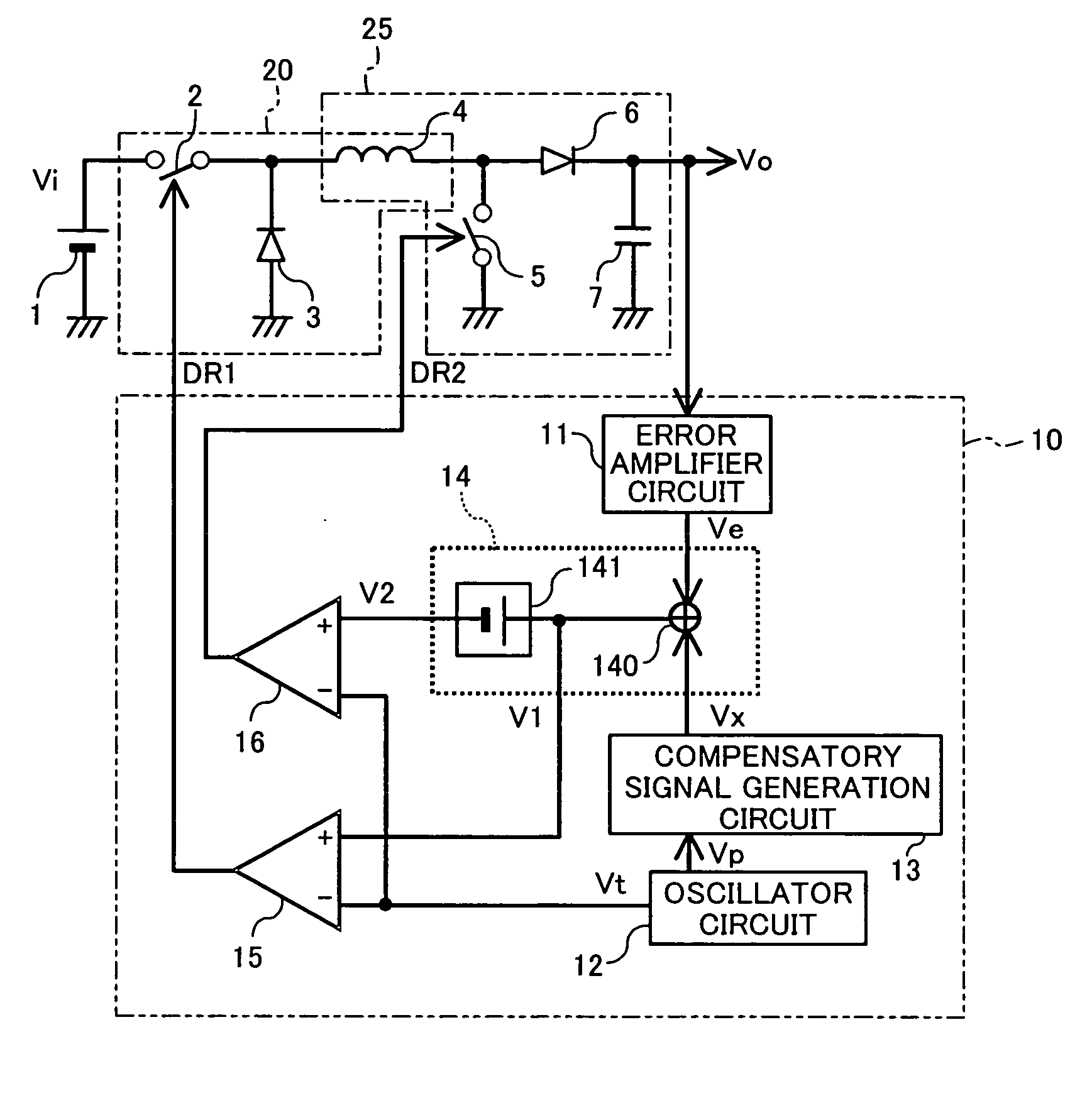Buck-boost converter
- Summary
- Abstract
- Description
- Claims
- Application Information
AI Technical Summary
Benefits of technology
Problems solved by technology
Method used
Image
Examples
first embodiment
[0047] A buck-boost converter according to a first embodiment of the present invention will be described with reference to the accompanying drawings.
[0048]FIG. 1 shows the circuit configuration of the buck-boost converter according to the first embodiment of the present invention. As shown in FIG. 1, the buck-boost converter of the first embodiment includes: a buck converter section 20, which includes a first switch 2, a first diode 3 serving as first rectifier means, and an inductor 4; a boost converter section 25, which shares the inductor 4 and includes a second switch 5, a second diode 6 serving as second rectifier means, and a capacitor 7 serving as smoothing means; and a control circuit 10, which generates and outputs a first driving signal DR1 for opening and closing the first switch 2 and a second driving signal DR2 for opening and closing the second switch 5. As the first switch 2 and the second switch 5, MOS transistors may be used, for example.
[0049] In the buck convert...
second embodiment
[0071] Hereinafter, a buck-boost converter according to a second embodiment of the present invention will be described with reference to the accompanying drawings.
[0072]FIG. 4 shows the circuit configuration of the buck-boost converter according to the second embodiment of the present invention. In FIG. 4, the same members as those of the buck-boost converter shown in FIG. 1 are identified by the same reference numerals and the description thereof will be thus omitted herein.
[0073] The buck-boost converter according to the second embodiment includes a control circuit 10A which is different in configuration from the control circuit 10 of the first embodiment.
[0074] As shown in FIG. 4, the control circuit 10A of the second embodiment includes: an error amplifier circuit 11A composed of an error amplifier 114 and an offset voltage source 115; a compensatory signal generation circuit 13A; and a control signal generation circuit 14A.
[0075] The error amplifier 114 of the error amplifi...
third embodiment
[0089] Hereinafter, a buck-boost converter according to a third embodiment of the present invention will be described with reference to the accompanying drawings.
[0090]FIG. 7A shows the circuit configuration of the buck-boost converter according to the third embodiment of the present invention. In FIG. 7A, the same members as those of the buck-boost converter shown in FIG. 1 are identified by the same reference numerals and the description thereof will be thus omitted herein.
[0091] The buck-boost converter according to the third embodiment includes a control circuit 10B which is different in configuration from the control circuit 10 of the first embodiment.
[0092] As shown in FIG. 7A, the control circuit 10B of the third embodiment includes: an oscillator circuit 12B, a compensatory signal generation circuit 13B; a control signal generation circuit 14B; a first comparator 15B; and a second comparator 16B.
[0093] The oscillator circuit 12B includes a signal generation circuit 220 a...
PUM
 Login to View More
Login to View More Abstract
Description
Claims
Application Information
 Login to View More
Login to View More - R&D
- Intellectual Property
- Life Sciences
- Materials
- Tech Scout
- Unparalleled Data Quality
- Higher Quality Content
- 60% Fewer Hallucinations
Browse by: Latest US Patents, China's latest patents, Technical Efficacy Thesaurus, Application Domain, Technology Topic, Popular Technical Reports.
© 2025 PatSnap. All rights reserved.Legal|Privacy policy|Modern Slavery Act Transparency Statement|Sitemap|About US| Contact US: help@patsnap.com



